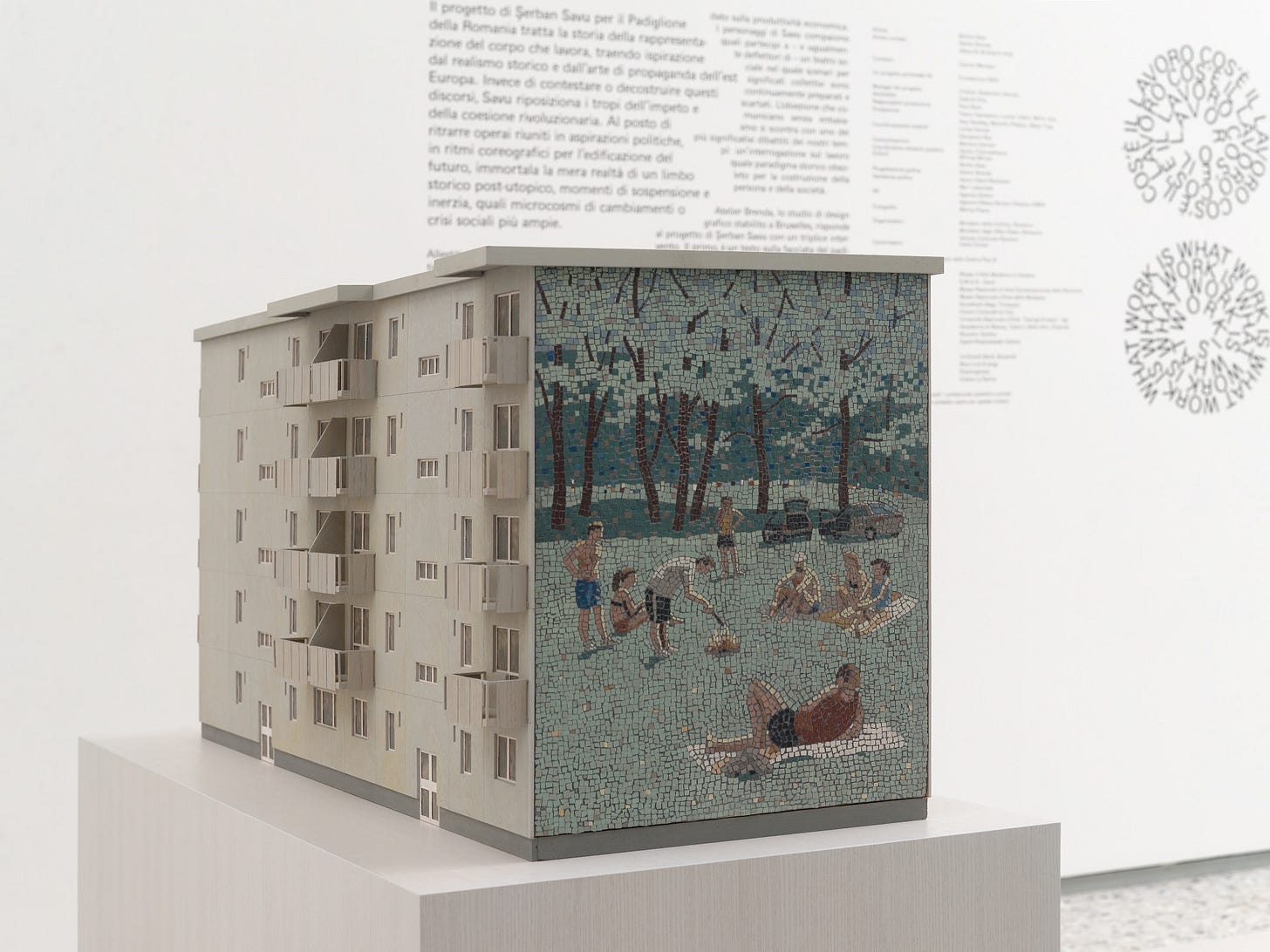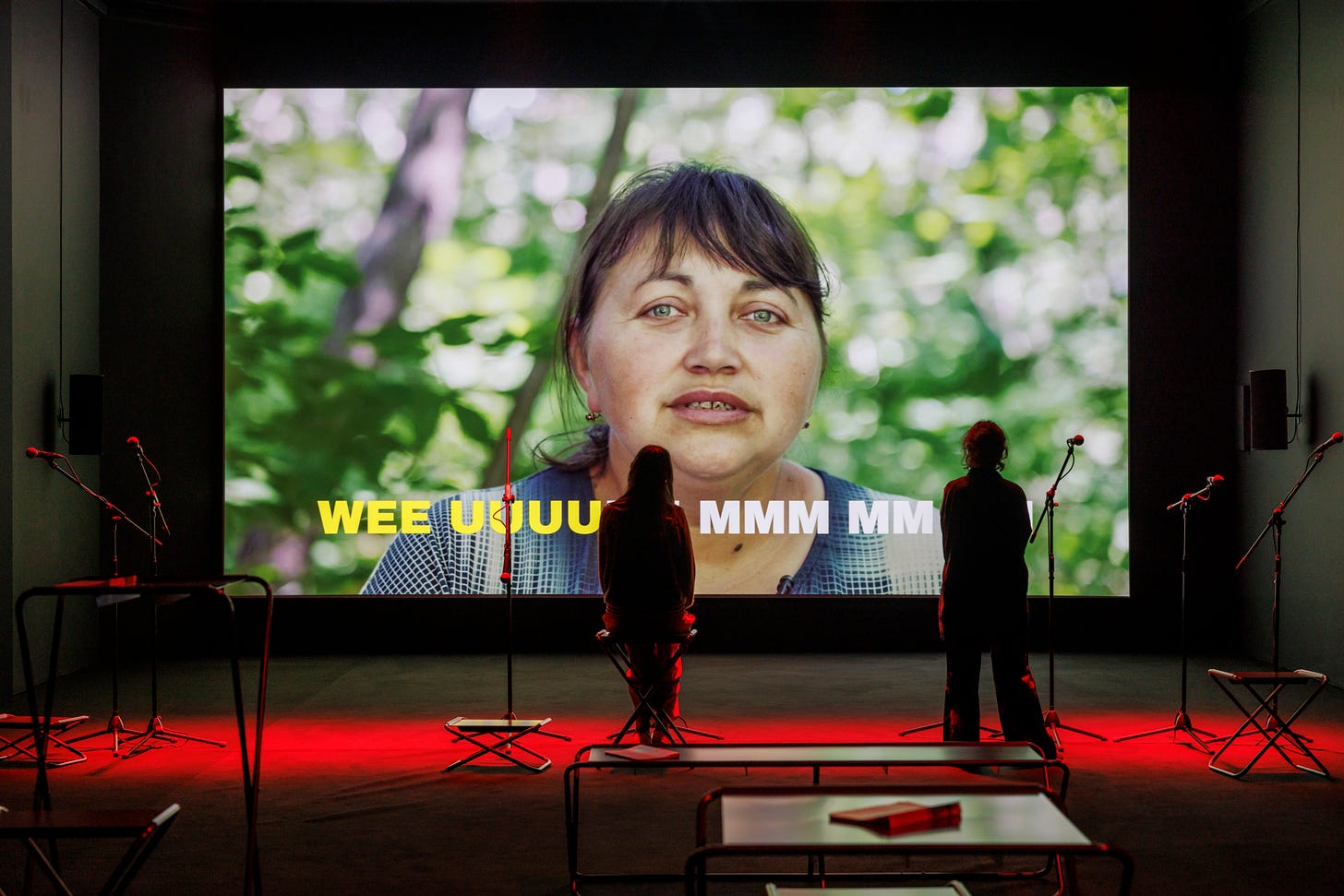The Venice Biennale 2024: The Giardini Pavilions (Part 1)
I finally get to share with you my favorite pavilions of this year's International Art Exhibition. We start with the Giardini.
Romania: What Work Is
What if getting that bread was not all there is to life? What if people valued rest the way they value work? Those are the questions that Serban Savu (Gen X, Romanian) explores in his exhibition What Work Is.
Serban created a huge altarpiece structure incorporating 45 paintings. The altar evokes religious devotion. And religion always plays a role in people’s lives, be it in the form of spirituality or political ideology. That’s why after the fall of the Eastern Bloc, countless churches were (re)built across Romania to fill the ideological vacuum left by Socialism.
What remains in a culture based on the idealization of work? It might be time to rest. Serban’s paintings are filled with people not working. Painters have a cigarette break, an electrician takes a nap instead of working on the cables, a construction worker takes a look at a flower onsite.

The styles Serban goes for vary from surrealist to impressionist. The serenity is giving Edward Hopper (1882-1967, American), although not as lonely. In between, he adds an easter egg, mashing real archeological sites, socialist murals, and religious mosaics in everyday settings of peace and calm. A couple maquettes stand in the exhibition space, one of them being a replica of the artist’s childhood home. Serban applied a mosaic on one wall depicting people celebrating May 1st, International Workers’ Day. They celebrate in the park, relaxing, doing nothing really worth of a monumental mosaic.
Out in town, students and professors create a large-scale version of that same mosaic that will be donated to a public space in Moldova. As I looked at the original photograph of the scene, I noticed Serban’s idealized perspective: No more trash lying in the park, the people arranged in a neat composition. He idealizes leisure the way socialism idealizes work. Time will pass regardless, you might as well just take a break.

National Pavilion of Romania, Giardini + New Gallery of Istituto Romeno di Cultura e Ricerca Umanistica (Palazzo Correr, Campo Santa Fosca, Cannaregio 2214), La Biennale di Venezia
Serbia: Exposition Coloniale
I’m always down bad for immersive exhibitions. Not the Van Gogh ones. I mean the tasteful type, like the Serbian Pavilion this year. A white ticket booth with Exposition Coloniale written on top is set right at the entrance. I’m thinking Bring it on! What are we going for? Western Colonialism in the Global South? World Exhibitions? The horrendous practice of human zoos? Inside, I was more than surprised to find myself in a small Balkan town.
A telephone booth. An outhouse toilet laced with Versace and Louis Vuitton wallpaper. A deli offering Eurovafel and Eurocrem. A sauna with the German haircare brand Schwarzkopf logo outside and clothes thrown on the benches inside. A motel room with a TV screen: It plays the ‘70s Coke ad “Hilltop”. Ayo that’s the Mad Men (2007-2015) finale! I know the kids want to buy the whole world a coke, but ironically, the Coke vending machine close by is chained up…

Aleksandar Denić (Baby Boomer, Serbian) created a world that is foreign but full of familiarity. His affinity for scenography is obvious. In this artificial environment, the illusion of a real place is disrupted through odd glitches. Apart from another doubled Coke sign in mirrored overlaid neon script, lightbulb letters spell EUROPE, hung in the very end of the hall, close to the ceiling. Why is it facing the wall, though? There is no stage? Where’s the audience?
When I think of it, identity, nationality, and belonging are performative. Aspects of daily life are stylized into an artificial stencil to fit in a group. The original Jugoslavia sign still adorns the pavilion’s façade. What makes a nation that once was two? Europe was never just a continental shape. It has always been a concept and a dream to be chased forever.

National Pavilion of Serbia, Giardini, 60th International Art Exhibition, La Biennale di Venezia
Poland: Repeat after Me II
The Polish Pavilion did a full 180 in its exhibition program: After the cultural ministry shifted back from right-wing politics, the new commissioner took the second finalist off the list from the open call.
The Ukrainian art collective OPEN GROUP transformed the Polish Pavilion into a karaoke sesh. The video installation inside features civilians who fled the war. Speaking about their experience, they imitate the sounds of weapons and encourage visitors to repeat after them infront of the microphones. The sound is transcribed in subtitles just like in a karaoke song.
The experience is surreal. The sounds of death and violence become human. The most important shift in warfare since World War I is its depersonalization. Such an odd thing to think about. Before WWI, fights were 1v1, human against human. In the 20th century, warfare turned into something abstract. A weapon could suddenly kill an entire village miles away, out of sight and earshot. A push of a button became enough to end the lives of millions. With drones, decisions are not even made in the field anymore but the safe distance of a screen in a secured room continents away.
When the performers imitate the sounds of machinery with their own bodies, they cut that distance between victim and agressor that characterizes war since the last century. The video combines two films from 2022 and 2024. Not much has changed unfortunately.
I felt the peer pressure in the room: Do I follow the video’s instructions or stay silent? The other visitors were uncertain as well as they slowly started to go along with the actors, awkwardly humming and buzzing. It’s as if I’m repeating the violence by repeating the sounds. The karaoke set up is absurd. A form of entertainment turned into an instrument of embodied empathy. So little is said and yet so much.

National Pavilion of Poland, Giardini, 60th International Art Exhibition, La Biennale di Venezia
Stay up to date on the Venice Biennale and subscribe to my newlsetter right here:
Thank you for reading this one! I’ll give you more recommendations on National Pavilions at the Biennale in the coming weeks. Subscribe, comment, like & share with a friend, thank uuuuuu <3
See you soon!!!
Jennifer
The Gen Z Art Critic





